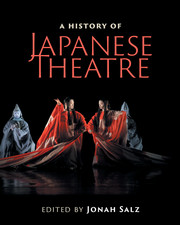Book contents
- Frontmatter
- Contents
- List of figures
- List of tables
- Contributors
- Contributors’ biographies
- Foreword
- Acknowledgments
- Note on Japanese terms
- List of abbreviations
- Timeline
- Editor's introduction
- I Traditional theatres
- Preface to Part I Japanese civilization arises
- II Modern theatres
- Preface to Part II
- III Arcs and patterns
- IV Theatre architecture
- Preface to Part IV Evolution of Japanese theatre architecture
- V Theatre criticism
- VI Intercultural influences
- Epilogue: Frozen words and mythology
- Further reading
- Index
Editor's introduction
Published online by Cambridge University Press: 05 July 2016
- Frontmatter
- Contents
- List of figures
- List of tables
- Contributors
- Contributors’ biographies
- Foreword
- Acknowledgments
- Note on Japanese terms
- List of abbreviations
- Timeline
- Editor's introduction
- I Traditional theatres
- Preface to Part I Japanese civilization arises
- II Modern theatres
- Preface to Part II
- III Arcs and patterns
- IV Theatre architecture
- Preface to Part IV Evolution of Japanese theatre architecture
- V Theatre criticism
- VI Intercultural influences
- Epilogue: Frozen words and mythology
- Further reading
- Index
Summary
Japanese theatre is a remarkably vital contemporary art and living museum, comprising performance genres spanning a millennium. The classical forms of noh, kyogen, kabuki, and bunraku are dynamic traditions developed centuries ago, yet still performed to devoted audiences. Plays often use the same costumes, properties, and scripts, and are performed by the same acting families as in their earliest establishment as genres. Moreover, temple worshipers, amateur hobbyists, and aristocratic and samurai patrons nurtured grassroots support and connoisseurship that continues today.
Alongside these continued popular classical forms, a rich and varied modern theatre has developed. Kabuki continues to draw daily packed houses even as the boom in Takarazuka girls' opera and Western-style musicals continues unabated. Pioneers of succeeding generations mine the “strata” of Japanese traditional performance for treasures. Western artists and scholars seeking alternatives to their own dialogue-driven theatre have long been fascinated by Japan's theatrical arts that combine ritual with entertainment, dance with drama, and poetry with spectacle. Japan's early adaptation of Western stage techniques, training, and playwrights has served as a model for many developing Asian theatrical cultures. This volume covers the vast range of this eclectic and original performance culture.
Waves of continuous tradition
Japan is a narrow island nation, isolated by dangerous seas. With nowhere else to export the artifacts and wisdom imported from the continent, Japan became the refiner, combiner, and conservator of a wide range of ancient culture, from India via China and Korea, and along the Silk Road. Itinerant and marginal entertainers learned to cater to rustic and urban, commoner, aristocrat, and warrior patrons. Artistic creation was codified by authoritative guilds appealing to spectators that often defied class distinctions. The iemoto headmaster system was the organizational instrument for maintaining such traditions and integrating innovation – or spurring competitive sectarianism.
However, for a supposedly conservative island once referred to as Wa (“harmony”), Japan has regularly suffered devastating cultural jolts. There were frequent, sudden ruptures in the slowly shifting tectonic plates of religion, politics, and Asian diplomatic relations, which caused unpredictable shudders, after-tremors, and occasional fissures and tsunami that altered the sociocultural landscape irrevocably. These shocks and waves were religious (Buddhist, Confucian, and Christian), political (power shifting from aristocrats to warriors to bureaucrats), and economic (agriculture to industry). Rural and urban artistic culture developed as relatively stable and familiar touchstones through such upheavals.
- Type
- Chapter
- Information
- A History of Japanese Theatre , pp. xxxiv - xliiPublisher: Cambridge University PressPrint publication year: 2016

